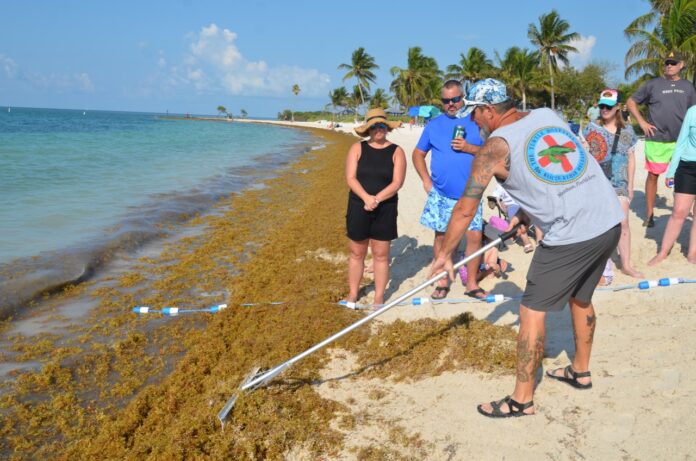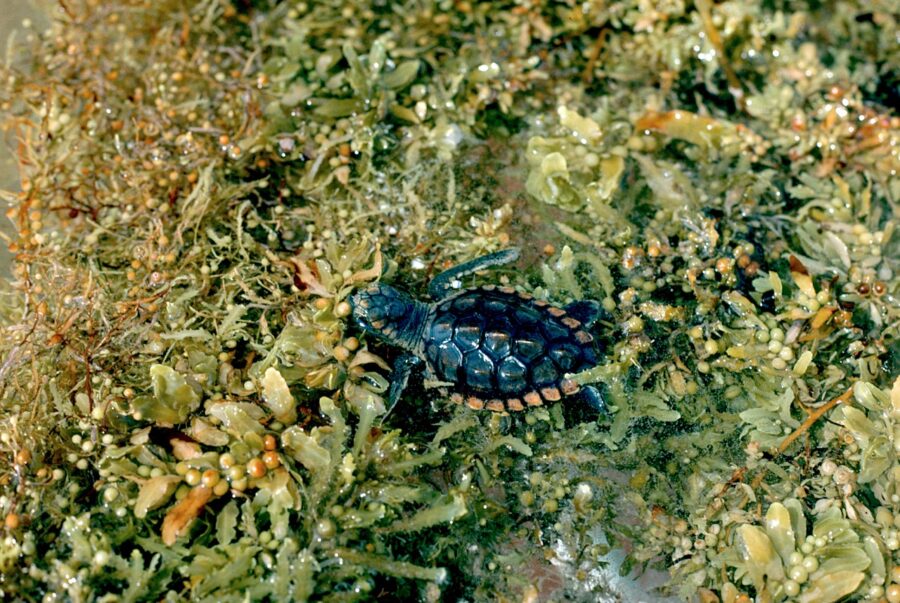
In March 2023, global reports of a massive sargassum “blob” headed straight for Florida caused many to worry about the potential effects on local wildlife and our tourism-based economy. Clumps and waves of seaweed have subsequently hit shorelines in the Keys, and concerns for sea turtles, in particular, have surfaced.
Sargassum is a leafy brown seaweed that floats on the open ocean, thanks to air-filled sacs. It originates in the Sargasso Sea – a wide swath of the tropical Atlantic Ocean bounded by four main ocean currents. Prior to 2011, sargassum did not grow in this region, said sargassum expert and Big Pine resident Brian Lapointe, research professor at Florida Atlantic University-Harbor Branch Oceanographic Institute. As the Great Atlantic Sargassum Belt (GASB) became a “new source region” for the seaweed, more of the brown plant has washed up on Keys beaches.
The blooms are natural phenomena that are amplified by natural and anthropogenic actions, Lapointe said. Sunlight and nutrients are used by the marine algae to grow, but increasing nutrient supply to the Atlantic basin from agricultural runoff is fertilizing more blooms.
“Since I began researching sargassum in the Keys in 1982, the nitrogen content has increased by 35%, which is a big surge in a relatively small amount of time,” Lapointe said. “The major rivers appear to be playing a key role in supply of both nitrogen and phosphorus, which include the Mississippi, Congo, Amazon and Orinoco.” Warming waters and changing ocean conditions could also accelerate growth.
At sea, floating sargassum provides very important habitat for young sea turtles, said Brian Stacy, NOAA Fisheries veterinary medical officer. It provides food and shelter to hatchlings, as well as to fish, seabirds and other marine animals.
April reports estimated the seaweed bloom – which is more accurately characterized as randomly-scattered clumps and mats than an actual blob – at roughly 13 million tons, Key Colony Beach’s Beth Ramsay-Vickrey told her local council in late April. Although the total quantity is large, the average density within the belt is rather low. Put into perspective, this means less than 0.1% of the ocean is covered by sargassum — despite the record-high numbers so far this year.
In the Keys, we’ve grown somewhat accustomed to waves of sargassum. However, “The arrival of sargassum influx from the GASB to the Keys was unusually early this year, beginning in February,” Lapointe noted. “This, together with a doubling of the size of the satellite image of the GASB between December 2022 and January 2023, suggested that 2023 could be a new record year for the size and impact of the GASB.”
The European Space Agency estimated that 2023’s mass – which is visible from space – is likely the largest seaweed bloom ever recorded. As these masses cross the Atlantic Ocean and beach in Florida, they smother local coastlines. This is when concerns begin.
According to NOAA, five of the seven known species of marine turtles live off the Florida Keys. All seven species are “threatened” or “endangered” under the Endangered Species Act. While males spend their entire lives in the ocean, adult females return to their birth beaches to nest and lay their eggs. Nesting sea turtles are very sensitive to artificial lighting, obstructions and other human disturbances, Stacy said, so covering the already-limited sandy patches in the Keys with seaweed doesn’t help.

“When sargassum washes onto shore in large quantities, it can act as a physical barrier for female sea turtles that are trying to nest, and can prevent hatchlings from emerging from nests and reaching the water,” said Stacy. Additionally, “sea turtles can become entrapped in it and are at risk of being stranded on land, which can be fatal.”
“Mama sea turtles are known to avoid beaches with heavy sargassum inundation and search for alternative nesting sites,” Lapointe added. “With increased competition for space, existing nests become disturbed, which can lead to loss of entire clutches of eggs. Turtles that do lay eggs in an accessible beach location often find that subsequent sargassum inundation prevents hatching.”
Lapointe has seen sargassum piled up at least five feet high and noted that endangered loggerhead hatchlings have an increased risk of predation due to sargassum inundation on the beach, even when beaches are raked of the buildup. FAU conservatively estimated net hatchling production losses from sargassum to reach 22% on Boca Raton’s beaches.
After sargassum beaches and smothers local coastlines, it decomposes under Florida’s hot sun – releasing gases smelling of rotting eggs. These contain high levels of toxic hydrogen sulfide and arsenic, which can also lead to the death of hatchlings and adult sea turtles, Lapointe said. Lapointe’s research has shown that the rotting seaweed also degrades local water quality and can lead to dangerous bacterial accumulation and oceanic dead zones.
While various shore-based mitigation procedures are in place – from manual removal at resorts to booms to keep sargassum from beaching – nothing, on a large scale, exists. Because NOAA considers sargassum “essential fish habitat” and “critical habitat” for sea turtles, harvesting at sea is prohibited.
“These federal rules need to be reconsidered, as the massive sargassum influx in these areas is doing more harm than good,” Lapointe said.
“The trajectory in the size of the GASB appears to be increasing. So, what will the impact be like in five years, 10 years, or 50 years?” he added.
Lapointe advocated for the development of a coastal protection plan in the Keys and South Florida to mitigate local effects.
“This could involve using booms to protect canals and boat basins and harvesting sargassum along shorelines where it is decomposing and causing environmental, economic and human health risks,” he said. “This would help protect beaches for residents and tourists alike.”


















